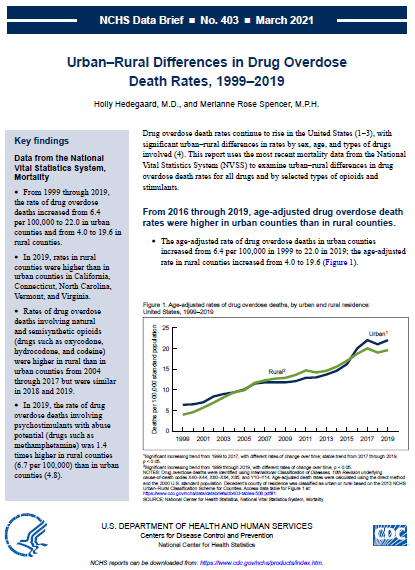Urban-Rural Differences in Drug Overdose Death Rates, 1999-2019
Posted on by Questions for Holly Hedegaard, Health Statistician and Lead Author of “Urban-Rural Differences in Drug Overdose Death Rates, 1999-2019.”
Questions for Holly Hedegaard, Health Statistician and Lead Author of “Urban-Rural Differences in Drug Overdose Death Rates, 1999-2019.”
Q: How do drug overdose death rates in urban and rural areas compare?
HH: Over the past 20 years, rates of drug overdose deaths have increased in both urban and rural areas. Rates in rural areas were higher than in urban areas from 2007 through 2015, but in 2016 that pattern changed. From 2016 through 2019, rates have been higher in urban areas than in rural areas.
Although urban rates are higher than rural rates nationally, for 5 states (California, Connecticut, North Carolina, Vermont, and Virginia), rates are higher in rural areas than in urban areas.
Q: Is this the most recent data you have on this topic? When do you plan on releasing 2020 data?
HH: Final 2020 data won’t be released until the end of 2021. In the interim, monthly provisional estimates of drug overdose death rates are available at https://www.cdc.gov/nchs/nvss/vsrr/drug-overdose-data.htm
Q: Was there a specific finding in the data that surprised you from this report?
HH: In this report, we looked at trends in rates for drug overdose deaths involving certain types of opioids, including natural and semisynthetic opioids. This group includes such drugs as hydrocodone, oxycodone, and codeine – drugs that are often thought of as prescription opioids. In looking at the trends from 1999 through 2019, the rates of drug overdose deaths involving natural and semisynthetic opioids were higher in rural than in urban areas from 2004 through 2017, but in 2018 and 2019, the urban and rural rates were similar, because of a decline in the rates in rural areas. We will continue to monitor whether this decline in the rate continues.
Q: What is the take home message for this report?
HH: The key messages from this report are: 1) for the past 20 years, drug overdose death rates have increased in both urban and rural areas, and 2) there are urban-rural differences in the rates of drug overdose deaths involving specific types of drugs. For example, for the past 20 years, rates of drug overdose deaths involving cocaine or heroin have been consistently higher in urban areas than in rural areas. In contrast, in recent years, rates of drug overdose deaths involving psychostimulants (such as methamphetamine) have been higher in rural areas than in urban areas.
Q: Do you think rural counties will go back to having higher drug overdose death rates in the future?
HH: It’s impossible to predict what will happen in the future. While a lot of resources have been devoted to prevention and treatment of drug overdose in recent years, new drugs are becoming available all the time. NCHS will continue to monitor drug overdose deaths to identify patterns to help inform public health efforts.
Posted on by

